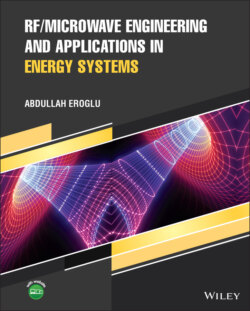Читать книгу RF/Microwave Engineering and Applications in Energy Systems - Abdullah Eroglu - Страница 49
1.4.2 Integral Forms of Maxwell's Equations
ОглавлениеLet's begin our analysis with Eq. (1.89). Taking the surface integral of both sides of Eq. (1.89) over surface S with contour C gives
(1.103)
We now apply Stokes' theorem as described in Section 1.3.6 for the left‐hand side of the equation in (1.103) as
(1.104)
From (1.103) and (1.105), we can now write as
(1.105)
or
(1.106)
In (1.106) is is the current through the surface S. Equation (1.106) is the integral form of the equation given in (1.89).
Similarly, we can express the integral form of Eq. (1.88) as
(1.107)
As a note, it is assumed that the magnetic current source does not exist. Taking the volume integral of both sides over volume V and surface S gives
(1.108)
We now apply divergence theorem as described in Section 1.3.5 for the left‐hand side of the equation in (1.108) as
(1.109)
From (1.108) and (1.109), we can write
(1.110)
Equation (1.110) is the integral form of the equation given in (1.91). Similarly, the integral form of Eq. (1.90) can be found as
(1.111)
In summary, the integral forms of Maxwell's equations are
(1.112)
(1.113)
(1.114)
(1.115)
